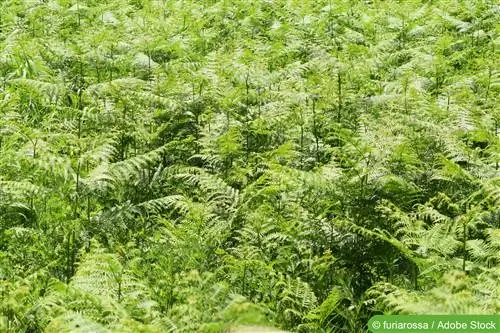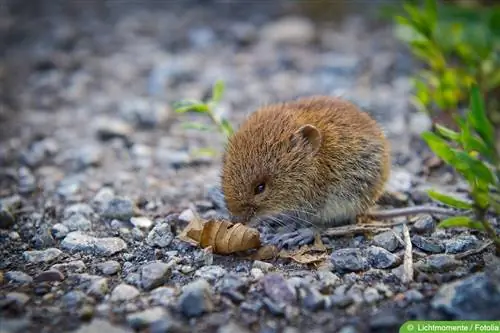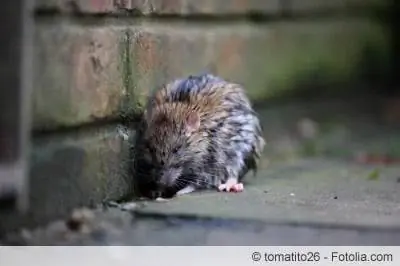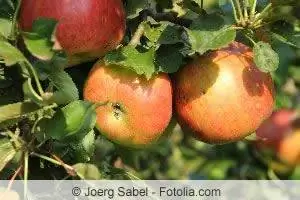- Author admin [email protected].
- Public 2023-12-17 03:39.
- Last modified 2025-06-01 06:48.
The bracken fern (Pteridium aquilinum) is large, beautiful and striking. It grows worldwide, except at the poles and in deserts. It particularly likes to colonize weakened locations, for example disturbed moor and heath areas, where it quickly becomes dominant and displaces the normal vegetation. If it finds optimal conditions and plenty of moisture, it can overgrow entire landscapes, as can be seen in Scotland and Ireland.
Bracken - an ambitious plant
It achieves this through several strategies: Everything around it is shaded by its strong fronds so that there is little strength left to grow. It also secretes chemical substances that prevent other plants from germinating and forms a thick layer of litter that not only decomposes poorly, but also compacts and thus changes the soil (litter accumulation). And it forms a branched rhizome that creeps in the ground and can grow very large and old. Rhizomes were found that were longer than 50 meters and older than a millennium(!).
So if you plant bracken freely in the garden, there is a good chance that it will reduce biodiversity as significantly as it does in the wild. Only a few species that grow everywhere like it can hold their own next to the bracken.
Caution
Brakern is poisonous
If you have children, the bracken fern does not belong in the garden for another reason: the entire plant is poisonous. Especially the young leaves, they have the highest ptaquiloside content, and the rhizomes contain thiaminase I. These are the two substances that are not only toxic, but are also said to have cancer-causing properties. It has also been shown that in the areas of the USA, Japan and New Zealand where the bracken fern is eaten young as wild lettuce, there is an increased incidence of esophageal tumors and stomach cancer.
The adult plant then produces a few more poisons, the spectrum covers half a page of a pharmaceutical manual. Accordingly, poisoning in different animal species manifests itself through different symptoms, all of which are more than unpleasant. Just half a kilo of young bracken leaves can put an adult cow's life in serious danger; it's hard to imagine how little a small child has to consume. Incidentally, inhaling the spores should also be avoided at all costs, as this will cause thiaminase to be absorbed.
Fighting bracken
That's why bracken has always been combated in agriculture; highly toxic herbicides were used in the past, which are no longer permitted today. It is not recommended to use today's herbicides: Not only are there to be fears of side effects on living creatures and other garden plants, they often cannot do anything against the bracken, and extremely rapid recolonization of the areas can often be observed. If you do want to use chemicals, you should first find out whether the products approved for garden use under the Plant Protection Act actually work against bracken.
In small areas, pulling out by hand is recommended, but in any case you should wear protective clothing and a breathing mask due to the toxic effects of the bracken. If the area is large, several combined measures will achieve the goal:
- Mowing in June, when the fronds are just beginning to develop, and at the end of July. After mowing, the broken litter should be removed, this removes some rhizomes and weakens remaining rhizomes, such as mulching, from which the bracken fern recovers quickly. It shouldn't be burned down under any circumstances, that seems to encourage it.
- Any fronds that still appear after these measures are snapped off and the breaking point is sprinkled with s alt. Snapping the fronds (repeat when a new one comes) severely inhibits the supply of nutrients. As the plant is also forced to sprout new fronds, the rhizome is also weakened. The control variant with s alt was tried out in the Black Forest and, according to tradition, is supposed to promote the weakening. Since the bracken loves acidic soils, you can also make life more difficult for it with a heavy dose of lime.
If you are still a fan of the impressive plant, you could keep it in a pot, for example. However, there are many more harmless fern species that can beautify the garden, for example the deer's tongue and ostrich fern, the brown-stemmed striped fern, the lady fern or the common worm fern. However, they are not suitable for a play garden either, as all ferns are poisonous plants.
Spread, appearance and flowering time
The bracken (Pteridium aquilinum) is the most common type of bracken and the only one that occurs in Germany. It spreads underground via its roots, the rhizomes, which enable it to survive even bad times. This allows it to spread widely and crowd out other plants. This can be particularly problematic in forests.
The bracken fern blooms in late summer and, from July onwards, forms spores on the underside of its leaves, which are spread by the wind, so that the plant can spread to distant places. It has light green leaves that hang down in an arch and are slightly curled at the edges. The shape of the stems with these leaves is somewhat reminiscent of a flying eagle, which is how this plant got its name.
The bracken as an ornamental plant
Despite the toxicity of this plant, the bracken fern is offered as an ornamental plant for gardens. Even in a natural garden, however, it should only be planted with a root barrier to prevent uncontrolled spread. It is suitable for moist soil and can be combined well with other plants, especially flowering plants. The best time to plant a bracken is spring.






